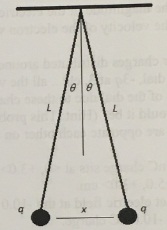Assignment:
1. You're looking over your buddy's class notes and notice the following things that are written down. For each item, state whether you agree or disagree with your friend, and explain briefly why.
a. "An electrically neutral object is neutral due to the absence of any charge."
b. "There are three types of charge, positive, negative, and neutral. Since opposites attract, a neutrally charged object is always attracted to either a positively or negatively charged object."
c. "The calculated force between two opposite charges is always negative. The calculated force between two like charges will always be positive."
d. "lf some metal object becomes positively charged, it actually loses mass in that process."
2. Two small spheres of equal mass m are suspended from strings of length Las shown in the figure. When the two spheres are each given an equal charge q they separate by a distance x, swinging out at an angle 0 from the vertical. Assume the angle is small enough that a small angle approximation is valid so you can set tan 0 = sin 0. Find/derive an equation for x in terms of q, L, m, g, and K

3. Two point charges are initially separated by 24.0 cm. They are then moved until the electric force on each is three times greater than initially. What is the new separation of the two charged objects?
4. Three +2.0 μC point charges are fixed in space in the following locations; the first at <1.0, 0, 0> cm, the second at <2.0, 0, 0> cm, and the third at <-4.0, 0, 0> cm.
a) Find the net electric field at the following locations; <0, 0, 0> cm, <-2.0, 0, 0> cm, <0, 0, 1.0> cm, and <1, 1, 1= cm.
b) For the point <-2.0, 0, 0> cm, what would be the force on a -3.0 RC charge at that location?
5. Three similar metal spheres of the same radius and mass on insulated stands are initially charged as follows: sphere A has +6.0 nC charge, sphere B has -2.0 nC of charge, and sphere C is neutral.
In this order, the spheres are touched for long enough for the charges to come to equilibrium and then separated again. Sphere A contacts B (and then separates.) Sphere A then touches C (and then separates.) Sphere C then touches B (and then separates.) After all this touching and separating, what is the charge on each sphere? Show that the total charge at the beginning and at the end has not changed (that is, that charge is conserved.)
6. A small styrofoam sphere of charge +q and mass m is dropped into the bottom of a glass test tube. A second sphere of same charge and mass is dropped in atop the first one and hovers somewhere above the bottom sphere. Derive an equation for the distance, d, the top sphere will float above the bottom sphere in terms of q, m, K, and g.
7. Consider three point charges at the comers of an equilateral triangle, its base sitting on the x-axis, with charge qA positioned at the origin, qB is at x=+3.50 cm, and qc is at the (top) third corner. qc = +2.60 pC, and the net electric force on tic is 375.0 N in the negative y direction.
a) Explain briefly but clearly how you know that qA and qB must have the same magnitude charge and what the sign of that charge must be.
b) Find the sign and magnitude of the charges on qA and q8.
8. Consider a cube with side length of s. At each corner of this cube is placed a charge q. Show that the magnitude of the electric field at the center of any face of this cube has a value of 2.1 8Kql,s2. Explain briefly what the direction of the field would be at one such point if all q's are a) positive, and b) negative.
9. An electron moving horizontally enters a region of constant electric field produced by a parallel-plate capacitor with the positive plate on the bottom and the negative plate on the top. The electric field is directed perfectly vertically. The electron enters the field with a speed of 4.55 x 106 m/s and exits the field 0.618 cm lower than it entered.
a) What is the magnitude of the electric field produced by the capacitor?
b) What is the velocity of the electron when it exits the capacitor's field?
10. Consider charges distributed around a clock face such that -q is positioned at the 1 on the dial, -2q at the 2 on the dial, -3q at 3, etc... all the way around to -12q at 12. Find the direction of the net electric field at the center of the dial due to these charges. When the hour hand of a clock is pointing in this direction, what time would it be?
11. A +10.0 nC charge sits at <0, +3.0> cm; a -5.0 nC charge is at <+5.0, 0> cm, and a -10.0 nC charge resides at <+5.0, +3.0> cm.
a) Find the net electric field at the -10.0 nC charge due to the other two charges and use this to find the net force on that -10.0 nC charge.
b) Find the net force on the -10.0 nC charge using Coulomb's Law only.
c) How do your two computed net forces compare? (If they are not the same, you'd better try again!)
12. Your study buddy tells you that the electric field surrounding a single point charge is uniform. Explain whether you agree or disagree with this idea and why. What would be a better word to describe this field?